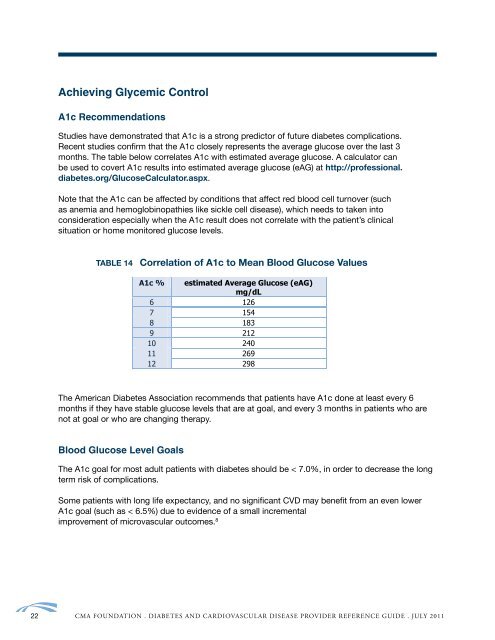Type 2 Diabetes Adult Outpatient Insulin Guidelines - CMA Foundation
Type 2 Diabetes Adult Outpatient Insulin Guidelines - CMA Foundation
Type 2 Diabetes Adult Outpatient Insulin Guidelines - CMA Foundation
Create successful ePaper yourself
Turn your PDF publications into a flip-book with our unique Google optimized e-Paper software.
Achieving Glycemic Control<br />
A1c Recommendations<br />
Studies have demonstrated that A1c is a strong predictor of future diabetes complications.<br />
Recent studies confirm that the A1c closely represents the average glucose over the last 3<br />
months. The table below correlates A1c with estimated average glucose. A calculator can<br />
be used to covert A1c results into estimated average glucose (eAG) at http://professional.<br />
diabetes.org/GlucoseCalculator.aspx.<br />
Note that the A1c can be affected by conditions that affect red blood cell turnover (such<br />
as anemia and hemoglobinopathies like sickle cell disease), which needs to taken into<br />
consideration especially when the A1c result does not correlate with the patient’s clinical<br />
situation or home monitored glucose levels.<br />
TAbLe 14 Correlation of A1c to Mean blood Glucose Values<br />
Table 14: Correlation of A1c to mean Blood Glucose Values<br />
A1c % estimated Average Glucose (eAG)<br />
mg/dL<br />
6 126<br />
7 154<br />
8 183<br />
9 212<br />
10 240<br />
11 269<br />
12 298<br />
The American <strong>Diabetes</strong> Association recommends that patients have A1c done at least every 6<br />
months if they have stable glucose levels that are at goal, and every 3 months in patients who are<br />
not at goal or who are changing therapy.<br />
Blood Glucose Level Goals<br />
The A1c goal for most adult patients with diabetes should be < 7.0%, in order to decrease the long<br />
term risk of complications.<br />
Some patients with long life expectancy, and no significant CVD may benefit from an even lower<br />
A1c goal (such as < 6.5%) due to evidence of a small incremental<br />
improvement of microvascular outcomes. 8<br />
22 <strong>CMA</strong> FoundAtion . diAbetes And CArdiovAsCulAr diseAse Provider reFerenCe guide . july 2011


